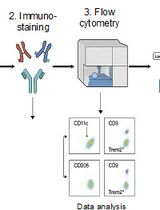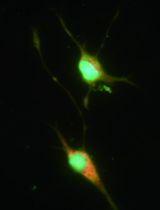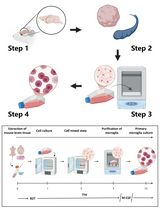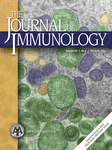- Submit a Protocol
- Receive Our Alerts
- Log in
- /
- Sign up
- My Bio Page
- Edit My Profile
- Change Password
- Log Out
- EN
- EN - English
- CN - 中文
- Protocols
- Articles and Issues
- For Authors
- About
- Become a Reviewer
- EN - English
- CN - 中文
- Home
- Protocols
- Articles and Issues
- For Authors
- About
- Become a Reviewer
Isolation and Culture of Peritoneal Cell-derived Mast Cells
Published: Vol 4, Iss 4, Feb 20, 2014 DOI: 10.21769/BioProtoc.1052 Views: 16789
Reviewed by: Anonymous reviewer(s)

Protocol Collections
Comprehensive collections of detailed, peer-reviewed protocols focusing on specific topics
Related protocols

Identification and Sorting of Adipose Inflammatory and Metabolically Activated Macrophages in Diet-Induced Obesity
Dan Wu [...] Weidong Wang
Oct 20, 2025 2094 Views

Selective Enrichment and Identification of Cerebrospinal Fluid-Contacting Neurons In Vitro via PKD2L1 Promoter-Driven Lentiviral System
Wei Tan [...] Qing Li
Nov 20, 2025 1244 Views

Revisiting Primary Microglia Isolation Protocol: An Improved Method for Microglia Extraction
Jianwei Li [...] Guohui Lu
Dec 5, 2025 1121 Views
Abstract
The generation of mast cells for in vitro studies comes from a variety of sources including mast cell lines (MC/9) (McCurdy et al., 2001), bone marrow-derived mast cells (BMMCs) (Supajatura et al., 2001), skin-derived mast cells (FSMCs) (Matsushima et al., 2004), peritoneal-derived mast cells (PMCs) (Hochdorfer et al., 2011) and peritoneal cell-derived cultured mast cells (PCMCs) (Vukman et al., 2012). PCMCs are generally used for in vitro studies because they are a more mature source of mast cells when compared to mast cells generated or obtained from other sources. They can differ, for example, in their pro-inflammatory responses to bacterial antigens and toll like receptors (TLRs) ligands (Mrabet-Dahbi et al., 2009). In comparison to BMMCs [see the protocol “Isolation and Culture of Bone Marrow-derived Mast Cells” (Vukman et al., 2014)] or mast cell lines they express a wider range of TLRs, and secrete significantly more cytokines when stimulated with TLR ligands (Mrabet-Dahbi et al., 2009). Therefore, when examining pro-inflammatory responses, mast cells generated from cells obtained from the peritoneal cavity give stronger responses. PCMCs can also be generated from knockout and transgenic mice making them a good source to examine specific factors important for mast cell function. However, due to the low yield of cells generated using this method (1 million per mouse) their use is restricted and therefore in most studies more than one source of mast cells may be required. The different sources of mast cells can display phenotypical and functional differences and therefore it is important that when designing an experiment, the correct cellular source is obtained. Here, we describe a protocol for the isolation and culture of murine mast cells from peritoneal cavity cells.
Keywords: Mast cellsMaterials and Reagents
- C57BL/6 mice or mouse model of choice (Harlan Laboratories, catalog number: 057 ; Charles River Laboratories International, catalog number: BLCSIFE49D )
- Industrial methylated spirit (IMS) (Lennox Laboratory Supplies, catalog number: CRTS10330716 )
- Sterile phosphate buffered saline (PBS) (Life Technologies, Gibco®, catalog number: 14190 )
- RPMI 1640 medium (Life Technologies, Gibco®, catalog number: 31870 )
- Fetal calf serum (FCS) (Life Technologies, Gibco®, catalog number: 10270 )
- Penicillin/streptomycin (Life Technologies, Gibco®, catalog number: 15140 )
- 2-Mercapto-ethanol (Sigma-Aldrich, catalog number: M3148 )
- L-glutamine (Sigma-Aldrich, catalog number: G7513 )
- Recombinant stem cell factor (SCF) (Sigma-Aldrich, catalog number: S9915 )
- Recombinant mouse interleukin-3 (IL-3) (Merck KGaA, catalog number: 407631 )
- Trypan blue stain (Sigma-Aldrich, catalog number: T8154 )
- APC-conjugated c-kit (eBioscience, catalog number: 17-1171 )
- Fitc congugted-FcεRI (eBioscience, catalog number: 11-5898 )
- Complete RPMI (see Recipes)
- Growth factors (see Recipes)
- Kimura dye (see Recipes)
- Toluidine blue solution (see Recipes)
- Saturated saponin (see Recipes)
- NaH2PO4 solution (see Recipes)
Equipment
- Sterile forceps
- Sterile scissors
- Sterile pipette
- Syringe (10 ml)
- Needle (19-gauge)
- Falcon tube (15 or 50 ml)
- Water bath
- pH meter
- Centrifuge
- 37 °C, 5% CO2 incubator
- T25 Cell culture flask (SARSTEDT AG, catalog number: 83.1810.502 )
- Haemocytometer
- Safety cabinet
Procedure
Note: All procedures are done in sterile environment in a safety cabinet.
Day 1
- Kill mouse by cervical dislocation.
- Spray mouse thoroughly with 70% alcohol (or IMS) and lay down on 70% alcohol soaked paper.
- Make a small incision below the sternum of the mouse and peel the fur back from the chest. Be careful not to puncture the peritoneum. Use sterile scissors and tweezers.
- Inject 1 ml air and 10 ml ice cold sterile PBS into the peritoneal cavity of the mouse using 10 ml syringe with a 19-gauge needle.
Note: 1:1 mixture of air and PBS can also be used to avoid leaking.
- Do not remove the needle.
- Give 30 sec massage on two sides of the mouse with fingers. Be careful not to push too hard the mouse.
- Collect the PBS with the cells into a Falcon tube with the syringe.
Note: Needle can be replaced for a bigger one to collect cells from the peritoneal cavity.
- Open the peritoneal cavity with new scissor and forceps and collect the rest of the PBS with a sterile pipette.
- Place the Falcon tube onto ice until centrifugation.
- Centrifuge cells at 4 °C with 300 x g for 10 min.
- Resuspend cells in 5 ml PBS per mouse.
- Centrifuge cells at 4 °C with 300 x g for 10 min.
- Resuspend cells in 5 ml medium [with 10 ng/ml IL-3 and 30 ng/ml SCF per two mice (approximately 1 million cells obtained per mouse)] and transfer them into a small culture flask.
- Put the flasks into the incubator (37 °C, 5% CO2).
Day 3
- Remove non-adherent cells by discarding the medium and add 5 ml fresh medium (with 10 ng/ml IL-3 and 30 ng/ml SCF) to every flask.
- Put them back into the incubator (37 °C, 5% CO2).
Day 6
- Add 5 ml fresh medium (with 10 ng/ml IL-3 and 30 ng/ml SCF) to every flask.
Day 9 or 10
- PCMCs are the non-adherent cells and can be used for experiment.
- Cell number and viability can be measured with trypan blue staining in haemocytometer.
- Purity can be tested with Kimura staining by mixing the cell suspension and Kimura dye (1:1) and after 5 min at 37 °C count cells under a light microscope. Mast cells will be stained red/purple (Kimura et al., 1973).
Note: Expected cell number is 0.5-1.5 x 106 PCMC/mouse after culturing. Purity is > 95% (Figure 1).

Figure 1. The purity of peritoneal-derived cultured mast cells is over 95% after 9 days of cultivation. Peritoneal cells were cultured for 9 days in complete RPMI medium in the presence of 10 ng/ml IL-3 and 30 ng/ml SCF. Purity was assessed on the basis of APC-conjugated c-kit and Fitc congugted-FcεRI cell surface expression measured by flow cytometry as previously described (Vukman et al., 2013). A: unstained control; B: double stained sample.
Recipes
- Complete RPMI
RPMI 1640 (500 ml)
10% FCS (50 ml per 450 ml of IMDM)
5 ml Penicillin (100 U/ml)/Streptomycin (100 μg/ml)
1 M 2-mercaptoethanol (add 25 μl to 500 ml for 50 μM final concentration)
- Growth factors (add to complete media prior to use)
Mouse SCF (30 μg/ml)
Mouse IL-3 (10 μg/ml)
- Kimura dye
Toluidine blue solution (50 ml)
Saturated saponin (2.27 ml)
NaH2PO4 solution (22.7 ml)
- Toluidine blue solution
Toluidine blue (25 mg) (0.5 mg/ml)
1.8% NaCl (18 g/L) (25 ml) (9 g/L)
Ethanol (100%) (11 ml) (22%)
Total 50 ml
- Saturated saponin
Saponin (200 mg) (4 mg/ml)
Ethanol (50%) (50 ml)
Total 50 ml
Note: Heat and vortex for 30 min.
- NaH2PO4 solution
60 mM NaH2PO4 (1.03 g)
Total 100 ml (pH 6.4)
Acknowledgments
The protocol described here was used in and adapted from the following publication (Vukman et al., 2012).
References
- Hochdorfer, T., Kuhny, M., Zorn, C. N., Hendriks, R. W., Vanhaesebroeck, B., Bohnacker, T., Krystal, G. and Huber, M. (2011). Activation of the PI3K pathway increases TLR-induced TNF-alpha and IL-6 but reduces IL-1beta production in mast cells. Cell Signal 23(5): 866-875.
- Kimura I., Moritani Y. and Tanizaki Y. (1973). Basophils in bronchial asthma with reference to regain-type allergy. Clin Allergy 3(2):195-202.
- Matsushima, H., Yamada, N., Matsue, H. and Shimada, S. (2004). TLR3-, TLR7-, and TLR9-mediated production of proinflammatory cytokines and chemokines from murine connective tissue type skin-derived mast cells but not from bone marrow-derived mast cells. J Immunol 173(1): 531-541.
- McCurdy, J. D., Lin, T. J. and Marshall, J. S. (2001). Toll-like receptor 4-mediated activation of murine mast cells. J Leukoc Biol 70(6): 977-984.
- Mrabet-Dahbi, S., Metz, M., Dudeck, A., Zuberbier, T. and Maurer, M. (2009). Murine mast cells secrete a unique profile of cytokines and prostaglandins in response to distinct TLR2 ligands. Exp Dermatol 18(5): 437-444.
- Supajatura, V., Ushio, H., Nakao, A., Okumura, K., Ra, C. and Ogawa, H. (2001). Protective roles of mast cells against enterobacterial infection are mediated by Toll-like receptor 4. J Immunol 167(4): 2250-2256.
- Sur, R., Cavender, D. and Malaviya, R. (2007). Different approaches to study mast cell functions. Int Immunopharmacol 7(5): 555-567.
- Vukman, K. V., Visnovitz, T., Adams, P. N., Metz, M., Maurer, M. and O'Neill, S. M. (2012). Mast cells cultured from IL-3-treated mice show impaired responses to bacterial antigen stimulation. Inflamm Res 61(1): 79-85.
- Vukman, K. V., Adams, P. N., Metz, M., Maurer, M. and O'Neill, S. M. (2013). Fasciola hepatica tegumental coat impairs mast cells' ability to drive Th1 immune responses. J Immunol 190(6): 2873-2879.
- Vukman, K. V., Metz, M., Maurer, M. and O'Neill, S. M. (2014). Isolation and culture of bone marrow-derived mast cells. Bio-protocol 4(4): e1053.
Article Information
Copyright
© 2014 The Authors; exclusive licensee Bio-protocol LLC.
How to cite
Vukman, K. V., Metz, M., Maurer, M. and O’Neill, S. M. (2014). Isolation and Culture of Peritoneal Cell-derived Mast Cells. Bio-protocol 4(4): e1052. DOI: 10.21769/BioProtoc.1052.
Category
Immunology > Immune cell isolation > Mast cell
Cell Biology > Cell isolation and culture > Cell isolation
Do you have any questions about this protocol?
Post your question to gather feedback from the community. We will also invite the authors of this article to respond.
Share
Bluesky
X
Copy link








